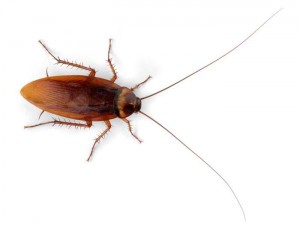Cockroach House Invasion
November 8, 2012 by admin
Filed under Pest Control
Cockroaches are insects of the order Blattaria or Blattodea, of which about 30 species out of 4,500 total are associated with human habitats. About four species are well known as pests.
Among the best-known pest species are the American cockroach, Periplaneta americana, which is about 30 mm (1.2 in) long, the German cockroach, Blattella germanica, about 15 mm (0.59 in) long, the Asian cockroach, Blattella asahinai, also about 15 mm (0.59 in) in length, and the Oriental cockroach, Blatta orientalis, about 25 mm (0.98 in). Tropical cockroaches are often much bigger, and extinct cockroach relatives and ‘roachoids’ such as the Carboniferous Archimylacris and the Permian Apthoroblattina were not as large as the biggest modern species.
Where are cockroaches found?
Cockroaches live in groups and are attracted to humidity, warmth and darkness, and are common in bathrooms, kitchens, dining rooms and sometimes bedrooms. Cockroaches secrete a pheromone (an attractant chemical) in their faeces, which attracts other cockroaches. Cockroaches dislike light and hide as soon as a light is turned on in a dark room. This habit can be used to find their hiding places. Egg cases (Oothecae) of some species of cockroaches can be found cemented to and/or dropped inside kitchen cabinets, behind refrigerators, and under or behind stoves. Though not all types of cockroaches drop their egg cases, empty shells of egg cases are an indicator of their presence.
What do cockroaches feed on?
Cockroaches feed on a wide variety of food (grease, crumbs, pet food, wax, gum, leftover food in empty food cans etc.). They also eat paper if it has glue on it, and some will feed on soap bars. Cockroaches can withstand long periods of starvation and can live for many days without water.
Do cockroaches transmit disease?
Cockroaches are scavengers. While walking on spoiled food in garbage containers, they pick up various bacterial organisms on their legs that they can later deposit on uncovered food. Cockroaches themselves are not implicated in the transmission of any diseases. However, many disease-causing organisms can grow and multiply in their guts and can then be deposited on silverware, plates etc. during defecation. For example, cockroaches can pick up disease-causing bacteria like Salmonella on their legs and later deposit them on foods and cause food poisoning. People continuously exposed to dust containing cockroach feces and crushed body parts become sensitized and may show allergic reaction and asthma after repeated exposure to such dust.
How can I control cockroach infestation in my home?
The key to prevent cockroach infestation indoors is sanitation both in and around the house. Empty garbage daily and keep the lid tightly closed at all times. Do not accumulate empty soda cans, beer bottles, food cans and especially not in brown paper bags and cardboard boxes inside the house. Tape openings around pipes under the kitchen and bathroom sinks to prevent infestation from neighbouring apartments. To prevent the entrance of cockroaches into homes: eliminate potential habitat areas outside the houses; seal cracks; and install screens on vents, windows and doors.
Baits are a safe way to control an infestation inside the home. Place bait under your refrigerator, behind and under the stove, and in the basement. Baits contain slow-acting poison that kills any cockroaches that eat it. Once poisoned, they usually salivate or defecate in their nest area, depositing poison that will kill other cockroaches.
Boric acid is used to control cockroaches, but its proper placement and use is essential to ensure its effectiveness. It can be purchased as boric acid insecticide formulations from hardware and grocery stores. The insecticide formulation packaged in plastic, squeezable bottles with narrow nozzles is the safest and easiest to use. Boric acid should be applied as a very thin layer of powder that the cockroaches cannot distinguish from dust. Apply it under and behind refrigerators, stoves, dishwashers, washing machines, cabinets, areas where plumbing pipes enter the floor, under sinks, etc. Do not apply it in areas where you prepare and/or store foods. Boric acid is a poison, so you should always store and apply it properly, especially if you have young children.
